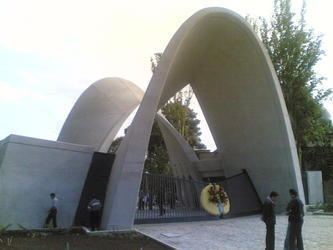Students 11957 (2015) Total enrollment 9,916 (2008) Founded 1929 Academic staff 430 | Established 1929 Postgraduates 5445 Phone +98 21 7724 0540 Undergraduates 5,525 | |
 | ||
Motto "Nothing is Impossible" President Dr. Mohammad ali Barkhordari Endowment 49.7 million USD (December 10, 2014) Notable alumni Similar Sharif University of Techno, Amirkabir University of Techno, K N Toosi University of Techno, Tarbiat Modares University, Shahid Beheshti University | ||
Iran university of science and technology iust music festival june 2002
The Iran University of Science and Technology (IUST) (Persian: دانشگاه علم و صنعت ایران) is a research institution and university of engineering and science in Iran. The university is home to 13 faculties offering undergraduate and postgraduate degrees in a range of engineering-based subjects as well as maths and physics. In 1995 IUST awarded Iran’s first PhDs in Materials, Metallurgical and Traffic Engineering. IUST is the only university in middle east which has School of Railway Engineering and School of Progress Engineering, its also the only university in Iran which has School of Automotive Engineering. There are also 12 research centres, nine centres of excellence and 19 specialised libraries as well as four satellite campuses in other parts of the country. IUST is located on Hengam Street in the Narmak neighborhood in northeast Tehran, IUST and its surrounding communities provide a cultural and recreational environment suited to the work of a major research institution.
Contents
- Iran university of science and technology iust music festival june 2002
- History
- Campus
- Academics
- Extracurricular activities and association
- Research
- World Rankings
- Notable alumni
- References
According to the results of 2016 Times Higher Education World University Rankings, Iran University of Science and Technology stands as the first university of the country, 57th among Asian Universities and 457th among world universities.QS World University Rankings 2016-2017 has announced Iran University of Science and Technology (IUST) as the second university of Iran and 491-500 among world universities. The 20,000 capacity IUST Stadium is their main sports venue.
Dr. M. A. Barkhordari is the dean.
Iran university of science and technology iust music festival june 2002
History
Iran University of Science and Technology was founded in 1929 as the first Iranian institution to train engineers, named the Governmental Technical Institute. Soon it was named Honarsaraye Ali—Advanced Art College in English.
In 1972, the title of the college upgraded to the Iran Faculty of Science and Technology due to the growth of the institute by the Ministry of Sciences. The faculty offered four-year bachelor's degrees in most areas of engineering and it is the first and for many years the only engineering university that consist of School of Architecture in the country. In 1978, it was granted university status by the Ministry of Sciences. Since then the institute was named Iran University of Science and Technology.
In 1990 it admitted students to Ph.D. programs in Civil Engineering and Materials Engineering fields. In 1995, IUST awarded the first Ph.D. degrees in Iran in the fields of Materials Engineering, Metallurgical Engineering and Traffic Engineering.
The main campus has 13 faculties and three other departments with 380 members of the academic board. On the main campus, 9,000 students are studying in 90 fields of engineering and sciences, out of which 2,000 are M.Sc. and 546 are Ph.D students. Over 35,000 students have graduated since 1932.
Campus
The main campus is located in the northeast of Tehran, expanded in 42 acres (170,000 m2). The campus includes faculty buildings, research centers, the main library, residential halls, the mosque, administrative buildings, sport playgrounds and covered spaces for sports such as football stadium, volleyball, basketball, and tennis courts.
IUST has four other campuses in the cities of Arak, Behshahr, Damavand, and Noor; the latter two are in progress.
Academics
IUST has 11 departments, 44 instruction groups, and 83 fields of study. Over 5,500 students study in the B.Sc program, over 5,400 students are studying in M.Sc. and over 940 are doing Ph.D. disciplines.
e-learning, foreign languages (TEFL), architectural engineering, automotive engineering, biomedical engineering, chemical engineering, chemistry, civil engineering, computer engineering, electrical engineering, industrial engineering, progress engineering, information technology, mathematical science, mechanical engineering (& aerospace engineering), materials engineering, (metallurgy), Physics science, railway engineering, Arak Branch, Behshahr Branch.
Extracurricular activities and association
The most important associations in Iran University of Science and Technology are:
Research
Advanced and High-Tech Research Activities at IUST include:
The University Research Centers include:
World Rankings
Times Higher Education
2016–2017: National Rank : 1
2015–2016: National Rank : 1, Rank in Asia : 57, International Rank : 475
2014–2015: National Rank : 3, Rank in Asia : 69
According to QS World University Rankings 2016-2017 Iran University of Science and Technology (IUST) ranked as the second university of Iran after Sharif University of Technology and 491-500 among world universities.
Iran University of Science and Technology (IUST) ranked 436th among World universities and 78th in Mathematics and computer science according to 2011-2014 CWTS Leiden Ranking.
In 2017, the US News & World Report ranked IUST Engineering Sciences 113th among world universities. Also, Materials Science of IUST ranked 169 among World Universities.
